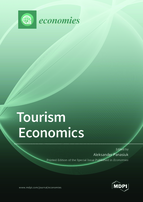Tourism Economics
A special issue of Economies (ISSN 2227-7099).
Deadline for manuscript submissions: closed (30 June 2022) | Viewed by 67238
Special Issue Editor
Interests: management; entrepreneurship; service economics; service management; tourism economics; tourism management; leisure studies; sport management; service marketing; regional policy
Special Issues, Collections and Topics in MDPI journals
Special Issue Information
Dear Colleagues,
The aim of this Special Edition of Economies is to present the current results of research on the functioning of the tourism market and its individual components. Topics of interest include tourism demand and tourism supply, while in terms of market units, the Special Issue will consider the issues of consumers of tourist services and tourists in tourism destinations, the functioning of tourist enterprises (hotels, tour operators, tourist agencies, tourist carriers, and others) and units shaping what is on offer in tourism destinations, the activities of entities regulating market mechanisms, i.e., tourism policy entities—international, national, regional and local—as well as tourist organizations. Detailed issues concern the structure of the tourism market, the market conditions and competitiveness, contemporary trends in tourism demand, changes in tourism supply along with new market offers, quality of tourist services, and changes in market regulations, especially domestic, but also global, e.g., related to tourist traffic. A special and most current area of problems is the functioning of the tourism market in the context of the COVID-19 pandemic and the directions of its reconstruction. Attention should also be paid to other crisis phenomena that already affect and are likely to have a greater impact soon, such as the climate crisis and migration crises in certain regions of the world (social, political, climate). Thus, topics of sustainable tourism, including overtourism, and social issues such as tourismphobia, are important too. The functioning of the tourism market is also influenced by new technologies, artificial intelligence, robotization, and thus the creation of alternative forms of spending leisure time.
Prof. Dr. Aleksander Panasiuk
Guest Editor
Manuscript Submission Information
Manuscripts should be submitted online at www.mdpi.com by registering and logging in to this website. Once you are registered, click here to go to the submission form. Manuscripts can be submitted until the deadline. All submissions that pass pre-check are peer-reviewed. Accepted papers will be published continuously in the journal (as soon as accepted) and will be listed together on the special issue website. Research articles, review articles as well as short communications are invited. For planned papers, a title and short abstract (about 100 words) can be sent to the Editorial Office for announcement on this website.
Submitted manuscripts should not have been published previously, nor be under consideration for publication elsewhere (except conference proceedings papers). All manuscripts are thoroughly refereed through a single-blind peer-review process. A guide for authors and other relevant information for submission of manuscripts is available on the Instructions for Authors page. Economies is an international peer-reviewed open access monthly journal published by MDPI.
Please visit the Instructions for Authors page before submitting a manuscript. The Article Processing Charge (APC) for publication in this open access journal is 1800 CHF (Swiss Francs). Submitted papers should be well formatted and use good English. Authors may use MDPI's English editing service prior to publication or during author revisions.
Keywords
- Tourism market
- Trends of tourism demand
- Tourist consumption
- Dynamics of tourism supply
- Tourist enterprises
- Tourism destinations
- Tourism policy
- Crisis on the tourism market






